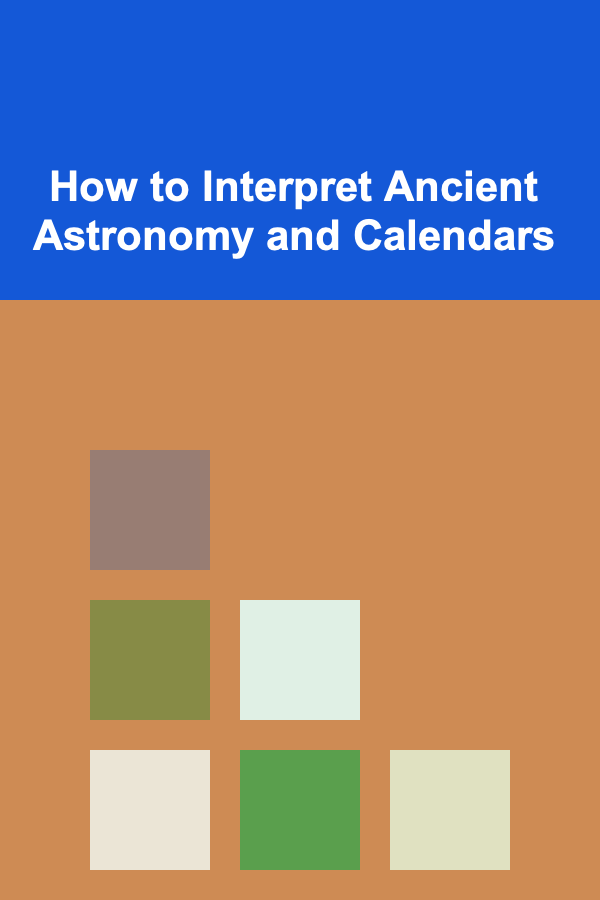
How to Interpret Ancient Astronomy and Calendars
ebook include PDF & Audio bundle (Micro Guide)
$12.99$10.99
Limited Time Offer! Order within the next:

Ancient astronomy and calendars hold a unique place in the history of human civilization. These systems not only reflect how ancient peoples viewed the cosmos but also reveal their understanding of time, the cycles of nature, and their ability to synchronize their activities with the natural world. Interpreting these systems today is a complex task that requires a multidisciplinary approach, combining knowledge of astronomy, history, archaeology, and even cultural studies.
In this article, we will explore how ancient civilizations interpreted the heavens, why they created calendars, and how we can interpret these ancient systems from a modern perspective. We will delve into specific cultures, such as the Babylonians, Mayans, Egyptians, and others, and examine the methods they used to understand celestial phenomena and track time.
The Foundations of Ancient Astronomy
Astronomy, as a science, is the study of celestial bodies and the universe. However, for ancient peoples, astronomy was more practical than theoretical. It was deeply intertwined with agriculture, religious practices, navigation, and governance. The night sky served as a map, guiding people in everything from when to plant crops to when to perform rituals.
The Cosmos as a Cycle
Ancient astronomy was built around the observation of celestial cycles. These cycles were used to measure time and predict events such as eclipses, solstices, and the movement of the planets. The most important cycles observed were:
- The Lunar Cycle: The phases of the moon were perhaps the most significant celestial event for many ancient cultures. The lunar cycle of about 29.5 days was used to structure months in many calendars.
- The Solar Cycle: The solar year, the time it takes for the Earth to complete one orbit around the Sun (approximately 365.25 days), was a crucial unit for many civilizations. This cycle defined the seasons and was closely linked to agricultural practices.
- The Sidereal Cycle: Ancient cultures were also aware of the stars and their movements. The sidereal year (the time it takes for the Earth to return to the same position relative to distant stars) was significant for certain cultures, such as the Babylonians.
- The Planetary Cycles: The motion of the planets was another area of keen interest. Ancient astronomers noted the periodic retrograde motion of planets like Mercury and Venus. These cycles were sometimes used to create predictions about the future or to track significant religious or political events.
Ancient Instruments of Observation
The ancient astronomers lacked telescopes, but they used a variety of ingenious methods and instruments to observe the skies. These included:
- The Gnomon: A simple sundial, the gnomon was used to measure the position of the Sun and determine time during the day.
- The Quadrant and Astrolabe: These instruments were used by ancient Greeks, Arabs, and others to measure the altitude of celestial bodies and to make more precise observations of the stars.
- Stone Circles and Pyramids: Many ancient cultures built structures aligned with the celestial bodies. Stonehenge in England, the Great Pyramids of Giza in Egypt, and the temples of the Maya in Central America are examples of these astronomical alignments.
These tools and techniques enabled ancient astronomers to not only track the movements of celestial bodies but also to develop sophisticated systems of timekeeping.
The Role of Calendars in Ancient Civilizations
Calendars were the practical application of astronomy, allowing ancient people to synchronize their activities with the celestial rhythms. The need for accurate calendars arose from agriculture, religious rituals, and governance.
Early Calendars
Most early calendars were based on the Moon's phases or the Sun's movements. The Egyptians, for example, used a solar calendar, while the Sumerians and Babylonians relied more on lunar cycles. These calendars were not purely theoretical constructs; they were essential for agricultural societies that needed to track the best times for planting, harvesting, and celebrating festivals.
The Lunar Calendar
Many ancient cultures, particularly in the Near East and Asia, used lunar calendars. The lunar month, determined by the Moon's phases, was the most common unit of timekeeping. For example:
- The Babylonians: The Babylonian calendar was based on the lunar cycle and used months of 29 or 30 days, depending on the sighting of the new moon. They also introduced the concept of intercalation (adding an extra month) to synchronize the lunar calendar with the solar year.
- The Chinese Calendar: The traditional Chinese calendar is lunisolar, meaning it takes into account both the lunar month and the solar year. The Chinese also used a system of 12-year cycles, which was incorporated into astrology.
- The Islamic Calendar: The Islamic calendar is a purely lunar calendar with months that last 29 or 30 days. Since it does not account for the solar year, the Islamic months drift through the solar calendar, moving ahead by about 10 to 12 days each year.
The Solar Calendar
Some civilizations, such as the Egyptians and later the Romans, developed solar calendars based on the Earth's orbit around the Sun. These calendars were more closely tied to the agricultural cycle, as the Sun's position in the sky determined the seasons.
- The Egyptian Calendar: The ancient Egyptians developed a solar calendar that divided the year into 12 months of 30 days each, plus five extra days at the end of the year. This calendar was essential for tracking the annual flooding of the Nile River, a key event in their agricultural cycle.
- The Julian Calendar: Introduced by Julius Caesar in 45 BCE, the Julian calendar was a solar calendar that added a leap year every four years to account for the extra 0.25 days in the solar year. This system was later modified by Pope Gregory XIII to create the Gregorian calendar, which is the one most of the world uses today.
The Lunisolar Calendar
Some cultures, such as the Mayans, developed lunisolar calendars, which combined the lunar and solar cycles. These calendars synchronized the Moon's phases with the Sun's position in the sky to maintain alignment with the agricultural cycle.
- The Mayan Calendar : The Mayans created one of the most sophisticated calendar systems of the ancient world. They used two overlapping cycles: the Haab' , a solar calendar of 365 days, and the Tzolk'in, a sacred 260-day calendar. The combination of these two cycles allowed the Mayans to track both time for agricultural purposes and for religious rituals.
Interpreting Ancient Astronomy and Calendars
Interpreting ancient astronomy and calendars today involves understanding both the practical and symbolic roles these systems played in their respective cultures. This process requires looking at these systems in context, considering the astronomical observations and calculations as well as the social, religious, and cultural frameworks that shaped them.
The Symbolism of Celestial Events
In many cultures, celestial events were not only seen as natural phenomena but also as symbolic events that had deeper meanings. For example:
- Eclipses: Eclipses were often seen as omens, either of doom or of divine intervention. The Babylonians, for example, used eclipses to predict the future and to determine the fate of kings.
- Solstices and Equinoxes: The solstices and equinoxes marked key moments in the year. These events were celebrated with festivals and rituals that often symbolized the triumph of light over darkness or life over death. For instance, the winter solstice marked the return of the Sun in many ancient cultures.
- The Zodiac: The constellations of the zodiac played a significant role in many cultures, influencing everything from personal destiny to national affairs. In Babylonian astronomy, for example, the position of the planets within the zodiac was thought to affect the fate of individuals and empires.
Astronomical Knowledge as Power
In many ancient cultures, the knowledge of the heavens was tightly controlled. Priests, kings, and astronomers who understood the movements of celestial bodies were often seen as possessing divine insight. This knowledge could be used to control agricultural cycles, time religious rituals, and even influence political events.
In ancient Mesopotamia, for instance, the priestly class was deeply involved in the study of celestial events, and their predictions often shaped the decisions of rulers. Similarly, the Mayan elite used their knowledge of astronomy to legitimize their rule and to conduct rituals that reinforced their divine authority.
Reconstructing Ancient Calendars
Reconstructing ancient calendars requires careful examination of surviving artifacts, texts, and monuments. Many ancient civilizations left behind inscriptions, tablets, and codices that provide valuable clues about their calendrical systems. These include:
- The Babylonian Tablets: Babylonian clay tablets contain detailed records of lunar observations and eclipse cycles, allowing modern scholars to reconstruct their calendar and even predict future celestial events.
- Mayan Codices: The Mayan codices, made of bark paper, contain intricate depictions of their calendar systems, showing the cycles of the Haab' and Tzolk'in. These codices provide a wealth of information about the Mayan understanding of time.
- Stone Monuments: Many ancient structures, such as Stonehenge and the Great Pyramids, were aligned with celestial events. These monuments offer insight into how ancient people used these structures to mark solstices, equinoxes, and other significant celestial events.
Conclusion
Interpreting ancient astronomy and calendars is a fascinating and complex task. It requires an understanding of not just the technical aspects of astronomical observation but also the cultural, religious, and political contexts in which these systems were developed. By studying these systems, we gain insight not only into the ancient world's view of the cosmos but also into the ways they structured their lives and societies. While the tools and methods used by ancient astronomers may seem primitive by modern standards, their achievements in tracking time and understanding the heavens were nothing short of extraordinary.

How to Build a Membership Recruitment Checklist for Your Environmental Organization: A Detailed Actionable Guide
Read More
How to Use Under-Sink Storage for Better Bathroom Organization
Read More
What Is the Best Way to Organize Seasonal Decorations?
Read More
How To Handle Disruptions and Unexpected Events
Read More
How to Get Cheap Rental Cars at Airports
Read More
How to Wear Graphic Tees for a Grown-Up Look
Read MoreOther Products

How to Build a Membership Recruitment Checklist for Your Environmental Organization: A Detailed Actionable Guide
Read More
How to Use Under-Sink Storage for Better Bathroom Organization
Read More
What Is the Best Way to Organize Seasonal Decorations?
Read More
How To Handle Disruptions and Unexpected Events
Read More
How to Get Cheap Rental Cars at Airports
Read More